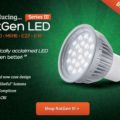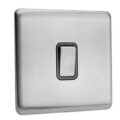Here at SimplyLED we get inquiries from all sorts of people and organizations about our products and LED light bulbs in general. Recently SimplyLED has been helping Roger Hunt, author of Old House Eco Handbook, with the current situation of the LED market….
Read the original piece Roger Hunt published on his blog Huntwriter. We picked out some of the highlights of the piece for our blog.
The quality of light has fascinated me since my days at drama school. I trained in technical theatre and saw how changes to the colour and intensity of light can be used to dramatic effect on stage.
Lighting has come a long way since then and, in the home, we’ve moved on from the basic incandescent light bulb or lamp. First we embraced halogen lamps for their sharp, crisp light. Then we became disheartened with low energy compact fluorescent lamps (CFLs). By and large CFLs haven’t done the cause of energy efficient lighting much good. The early versions in particular took a lot of time to come to full brightness and, even then, the quality of light wasn’t necessarily great.
Now we have LED light bulbs and, unlike CFLs, they’re likely to become the light source of choice. LED light bulbs (light emitting diodes) use a very small amount of energy to pack a lot of punch and, potentially, they last for a long time. That said, they haven’t always had a good press. Poor quality of light, lamp failures and high prices have not endeared them to everyone.
That’s changing. The LED market is constantly and quickly advancing and the price of the lamps is rapidly dropping. I was reminded of this when I tried the new GU10 LED NxtGen LITE from SimplyLED. For those with technical minds, it consumes 5 watts of electricity, provides 320 useful lumens, is available in warm white (3000k) and comes with an energy rating of A+.
The real proof of any lamp’s capability is when you turn it on. This lamp is designed to be an exact replacement for 50w halogen lamps – something of a holy grail in low energy lighting circles. Once fitted in the downlighters of my office it certainly proved its worth. It’s the quality of the light that counts and, with this lamp, it isn’t bad. It maybe lacks what I can only describe as the ‘sharpness’ of a halogen lamp but the light is pleasantly bright and it’s the first low energy lamp where I haven’t felt compelled to turn on my 50w halogen desk lamp when working.
This brings me to an important point; mentioning watts is dangerous when comparing lamps. Watts only tell us how much power a lamp consumes, not how much light it generates.
Usefully, updated EU Energy Related Product (ErP) legislation introduced in September – which the NexGen LITE meets – has standardised the minimum quality of directional (spotlight) LED lamps. This makes it easier to compare equivalent light output against halogen. For example, for a GU10 LED to be the equivalent of a 50w 240-volt halogen, it needs to offer at least 300 useful lumens. Don’t get caught out though, if you’re replacing a 12-volt MR16 50w halogen with an LED MR16 it should have a useful lumens rating of 540.
This may sound unnecessarily complicated but, in the future, we won’t be comparing LED light bulbs with the lamps of the past. Instead, LED light bulbs will be ubiquitous and we’ll simply be enjoying the high quality, low energy light that they can offer.
Thanks to Roger for letting us share the article. To see the original please click here.
Date: January 14, 2014
Tags: announcements bulb eco GU10 leds technology
Here at SimplyLED we get inquiries from all sorts of people and organizations about our products and LED light bulbs in general.




